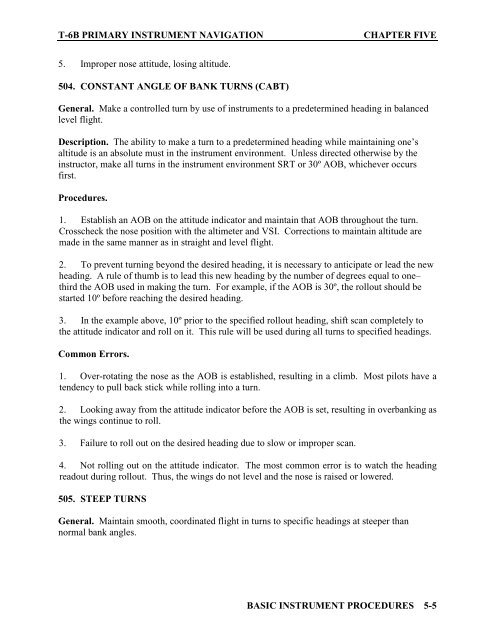Flight Training Instruction - Cnatra - U.S. Navy
Flight Training Instruction - Cnatra - U.S. Navy
Flight Training Instruction - Cnatra - U.S. Navy
Create successful ePaper yourself
Turn your PDF publications into a flip-book with our unique Google optimized e-Paper software.
T-6B PRIMARY INSTRUMENT NAVIGATION CHAPTER FIVE<br />
5. Improper nose attitude, losing altitude.<br />
504. CONSTANT ANGLE OF BANK TURNS (CABT)<br />
General. Make a controlled turn by use of instruments to a predetermined heading in balanced<br />
level flight.<br />
Description. The ability to make a turn to a predetermined heading while maintaining one’s<br />
altitude is an absolute must in the instrument environment. Unless directed otherwise by the<br />
instructor, make all turns in the instrument environment SRT or 30º AOB, whichever occurs<br />
first.<br />
Procedures.<br />
1. Establish an AOB on the attitude indicator and maintain that AOB throughout the turn.<br />
Crosscheck the nose position with the altimeter and VSI. Corrections to maintain altitude are<br />
made in the same manner as in straight and level flight.<br />
2. To prevent turning beyond the desired heading, it is necessary to anticipate or lead the new<br />
heading. A rule of thumb is to lead this new heading by the number of degrees equal to one–<br />
third the AOB used in making the turn. For example, if the AOB is 30º, the rollout should be<br />
started 10º before reaching the desired heading.<br />
3. In the example above, 10º prior to the specified rollout heading, shift scan completely to<br />
the attitude indicator and roll on it. This rule will be used during all turns to specified headings.<br />
Common Errors.<br />
1. Over-rotating the nose as the AOB is established, resulting in a climb. Most pilots have a<br />
tendency to pull back stick while rolling into a turn.<br />
2. Looking away from the attitude indicator before the AOB is set, resulting in overbanking as<br />
the wings continue to roll.<br />
3. Failure to roll out on the desired heading due to slow or improper scan.<br />
4. Not rolling out on the attitude indicator. The most common error is to watch the heading<br />
readout during rollout. Thus, the wings do not level and the nose is raised or lowered.<br />
505. STEEP TURNS<br />
General. Maintain smooth, coordinated flight in turns to specific headings at steeper than<br />
normal bank angles.<br />
BASIC INSTRUMENT PROCEDURES 5-5
















